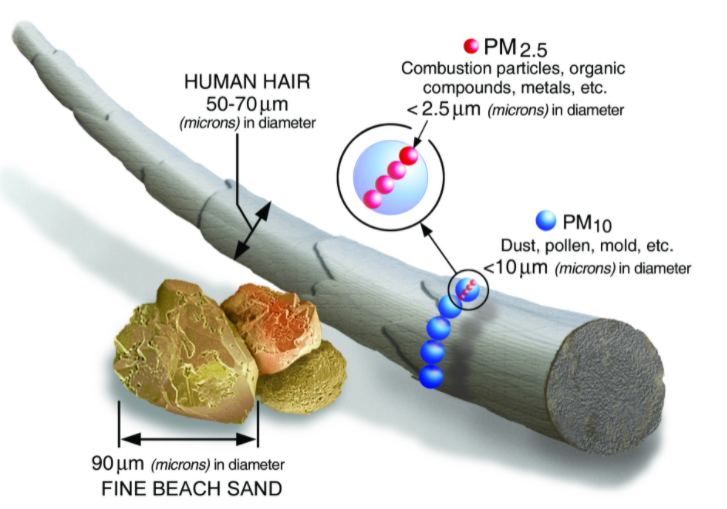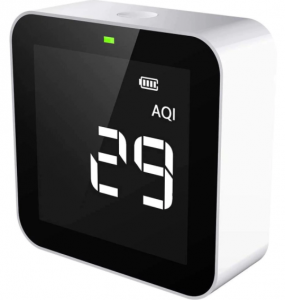What is PM 2.5? PM 2.5 stands for Particulate Matter that measures 2.5 microns or less. Just for perspective, PM2.5 is over 30 times smaller than a particle of beach sand. It’s pretty hard to see one particle of sand, so this means that PM2.5 is not visible to the naked eye.

Today, we delve more into the question “What is PM2.5?” so that you understand what it means and how to tackle it.
Sources of PM2.5
Where does PM2.5 come from? Well, air pollution happens both indoors and outdoors. Therefore, expect PM2.5 to be present outside and inside your home. Indoor sources of PM2.5 include:
- The kitchen – cooking smells/fumes
- Smoking – cigars, cigarettes, and marijuana
- Bacteria
- Viruses
- Inside public transport means, e.g., trains – iron, chromium, manganese, copper
You can also encounter PM2.5 outdoors from:
- Exhaust from motor vehicles
- Factories
- Coal power plants

Does PM2.5 Pose a Health Risk to Us?
Dubbed “The Silent Killer” by some, PM2.5 can indeed cause many health issues. Since most of these substances float in the air, they can easily find their way into our bodies and bloodstream.
These harmful particles go through the respiratory tract and into the lungs as you breathe. From here, they are absorbed into the blood and traverse the body from head to toe. The effects range from minor to severe.
On the lower scale, you are likely to experience:
- Coughing
- Sneezing
- Itchy eyes
- Headaches
- Runny nose
- Shortness of breath
- Irritable respiratory tract – nasal cavity and throat
- Tiredness
More serious long-term effects include:
- High blood pressure
- Heart disease
- Cardiac arrest
- Worsens asthma
- Depressed lung function
- Low IQ in children
- Lung cancer
- Premature death
Also, you may experience symptoms that are unique to a particular metallic element that you may have inhaled.
How to know if Your Indoor Air has PM2.5
Apart from experiencing such symptoms as those above, you can take a proactive approach to fight PM2.5. First, you can purchase a good air quality monitor that will let you know how much particulate matter is in the air at any particular time.

Another tool you can use is a mobile app. If you have a smartphone, visit the Play Store (Android users) or App Store (iPhone users) and look for an air quality app. Such apps provide information on PM 2.5 levels outside.
Pollution levels near your home can be a good indicator of how much PM2.5 is inside your house.
Also, if you live in a much-polluted neighbourhood, you can look outside and know if the air is too dirty. If it seems hazy, the chances are that the PM2.5 levels are too high. However, ensure that you can differentiate pollution from mist and fog.
Besides, depending on the specific particulate matter, say it’s from combustion in a nearby plant, you can smell PM2.5. Also, PM2.5 tends to change natural light to orange in some places.
Lastly, some air purifiers measure PM2.5 and display it on a screen. So, buying a good air purifier can be a way of measuring PM2.5.
What PM 2.5 Levels Are Safe?
It is nearly impossible to get rid of Particulate Matter 2.5 with all the motor vehicles on our roads, industrial, and power generating plants. So, the WHO has come up with guidelines on PM2.5 levels that are somewhat safe for humans.
However, note that these substances affect us long-term unless you already have allergies, asthma, and other underlying health problems. The recommended safe level of PM 2.5 by the World Health Organization is about 15 microns per cubic metres (24-hour average).
The annual average should be about 5 microns per cubic metre. So, ensure that you always check the air quality monitor and take appropriate action (like switching on the air purifier) when the levels are too high.
Also, please note that various jurisdictions have their recommendations of safe levels. For example, according to the Ministry of Environment and Climate Change Strategy:
“The Canadian Ambient Air Quality Annual Standard for PM2.5 is achieved when annual levels are 10.0 micrograms per cubic metre (µg/m3) or lower.”
How to Mitigate Effects of PM2.5
As we have already seen, PM 2.5 is everywhere – inside our houses and outdoors. Most places have moderate levels of PM2.5, but others have lots of it. To be safe from the many issues that can arise from inhaling PM 2.5, always wear a mask when outside.
The best masks to protect you from PM2.5 are surgical masks, N95, N99, and KN95.
To remove PM2.5 from indoor air, you can:
- Open your windows when cooking or smoking.
- Close your windows when the PM2.5 levels are too high outside to prevent polluted air from entering the house.
- Run your air purifier. Finding a good air purifier is the key to eradicating PM2.5 from your home. You can turn on the unit when PM2.5 levels are very high or let it run 24/7 – there are other particles to be removed too.
If you still haven’t acquired an air purifier, you can check out our review of the best air purifiers in Canada for some fantastic options.
Conclusion
PM2.5 stands for Particulate Matter that measures 2.5 microns or below. These particles are too tiny to be seen by the naked eye and can be harmful. So, the best thing to do is know whether you’re within the acceptable levels.
You can do this by looking outside, buying a monitor, or using a mobile app. To remove PM 2.5 from your indoor air, invest in a good air purifier to avoid undue stress and unnecessary medical bills.
This YouTube video by Smart Air sheds more light on PM2.5:
